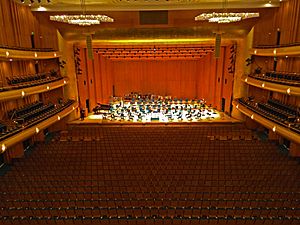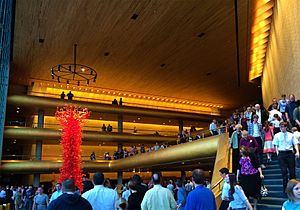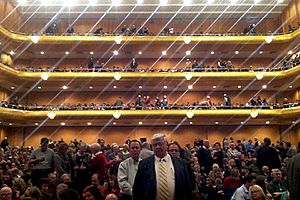Abravanel Hall facts for kids
|
Abravanel Hall
|
|
 |
|
| Former names | Symphony Hall (1979–1993) |
|---|---|
| Location | 123 W. South Temple Salt Lake City, Utah |
| Owner | Salt Lake County |
| Type | Concert hall |
| Seating type | Reserved |
| Capacity | 2,768 |
| Construction | |
| Built | 1976-1979 |
| Opened | 1979 |
| Website | |
| [1] | |
Abravanel Hall is a concert hall in Salt Lake City, Utah. It is the main home for the Utah Symphony. This building is part of the Salt Lake County Center for the Arts. It is a well-known architectural landmark in the city. The hall is located right next to Temple Square and the Salt Palace. It can hold up to 2,811 people for concerts and other events.
Contents
History of Abravanel Hall
The Utah Symphony wanted a special place for their music. So, they created a committee to help design a new hall. This group included Maurice Abravanel, O.C. Tanner, and Jack Gallivan. They worked with the main architect, Bob Fowler. Building the hall took three years and cost $12 million.
Opening and Renaming
Abravanel Hall first opened its doors in September 1979. It was first called Symphony Hall. In May 1993, the hall was renamed. It was given the name Maurice Abravanel Hall. This was to honor Maurice Abravanel, who was the conductor of the Utah Symphony.
Hall Expansion and Olympic Events
In 1998, the hall was made bigger. New restrooms were added that were easy for wheelchairs to use. A new ticket office was also built. A new room for receptions was created too. The bigger hall hosted many events during the 2002 Olympics arts festival. One event was a concert with Audra McDonald and the Utah Symphony. During the games, the building was also decorated with an image of a biathlete.
Architecture and Design
Abravanel Hall is built in a special way. It is like a concrete building inside a brick building. FFKR Architects designed the building. Dr. Cyril M. Harris helped with the sound design. His goal was to make the sound inside the hall perfect.
Acoustic Excellence
Dr. Harris was a top expert in sound for buildings. He also worked on other famous halls. These include Avery Fisher Hall in New York City and the Kennedy Center in Washington, D.C.. He also worked on Orchestra Hall in Minneapolis, Minnesota.
Hall Shape and Stage
The hall has a rectangular shape. This is like some of the best symphony halls in the world. Examples include the Grosser Musikvereinssaal in Vienna and the Concertgebouw in Amsterdam. Symphony Hall in Boston is another example. The stage was made only for concerts. It does not have a proscenium, which means it feels like part of the audience. Cello and bass players can even make small holes in the stage. This helps their instrument's sound mix with the wood of the hall.
Sound Control Features
To enter the concert hall, people walk through special hallways. These are called sound lock corridors. They stop noise from the lobby from reaching the concert area. Inside the hall, the walls and ceilings have curved surfaces. There are no perfect ninety-degree angles. This is because sharp corners can affect how sound travels.
Chandeliers and Lobby
Six large brass chandeliers hang from the ceiling. Each one is 16 by 16 feet (4.9 by 4.9 meters). They have 18,000 hand-cut beads and prisms. These beautiful crystals came from Austria and Czechoslovakia.
The lobby is four stories tall. It has a white oak and brass ceiling. A large glass wall, about 5,400 square feet (500 square meters), covers much of the lobby's east side. The lobby itself is amazing to look at. It has many levels and a staircase that goes up and to the left. The stairs and balconies are covered in gold leaf. In the middle of the lobby is a 30-foot (9.1 meter) tall red glass sculpture. It is called The Olympic Tower. Famous artist Dale Chihuly made it. This artwork was bought in 2002. Private donors and the Salt Lake Organizing Committee helped raise the money. The sculpture was valued at $900,000. Chihuly sold it for less. This was because it would stay at Abravanel Hall. Also, the public could see it without buying a concert ticket.
Images for kids
See also
 In Spanish: Sala Abravanel para niños
In Spanish: Sala Abravanel para niños





